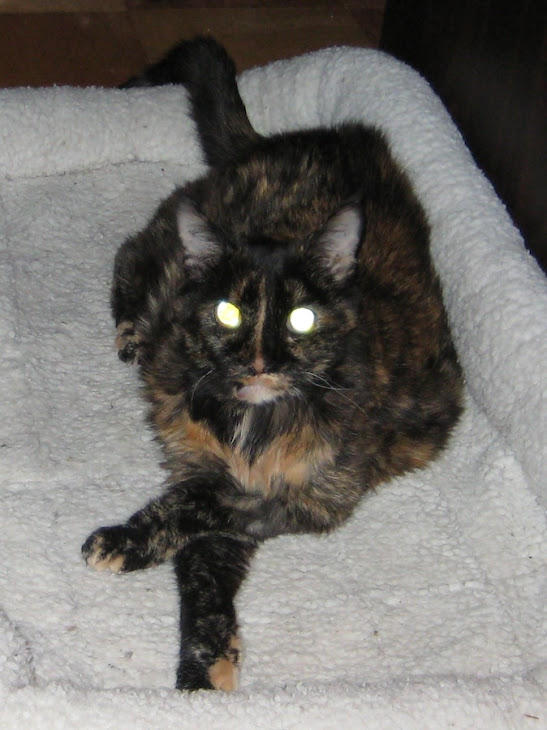Is Your Cat Due For a Checkup?
August 18-24 is National Take Your Cat to the Vet Week, according to Petfinder. While they don't expect every cat owner to get into the vet's office this week, they are reminding people to schedule a well-cat visit for a checkup. Cats should visit the veterinarian once a year, or every six months for senior cats. Yet cats only see their vets about half as often as do dogs.
A lot of us have been experiencing tight budgets, and it's easy to put off "luxuries" like veterinary care for your cats in tough times, especially when we can find so much information about cat health online. But caring properly for your furry family members is not really a luxury. And it can actually save you money in the long run by identifying health problems before they get to a critical stage.
Why endure the hassle of taking kitty to the vet when nothing's wrong? Because cats are masters at masking symptoms of illness. It's a survival tactic in the wild. So by the time kitty actually shows symptoms of an illness, the disease or condition has often progressed to the point that it's much harder (and more expensive) to treat. During a well-cat visit, your vet will give kitty a nose-to-tail checkup that can identify things like obesity that could lead to diabetes, parasites, irregular heart rhythm that could indicate cardiovascular disease, unusual growths that could be tumors, or tooth and gum disease that could damage kitty's major organs. If your vet sees your cat regularly, something that's out of the norm can more easily be identified.
Then there's the issue of vaccinations. We all know the importance of an annual rabies vaccine that is actually required by law in most places, but there are several other recommended vaccines that can spare your cat from fatal feline diseases. These include feline distemper, upper respiratory infections, and feline leukemia.
Lab work on your cat is also a good idea. This includes tests on kitty's blood, urine, and fecal matter that can identify abnormalities that may mean disease. Typical blood tests include a Complete Blood Count (CBC) that can indicate anemia, leukemia, parasites, or other infections. A blood chemistry test makes sure the levels of minerals and electrolytes in your cat's system are at the optimal levels. Urinalysis checks for things like protein, sugar, or blood cells in the urine, all of which could indicate diseases. And the fecal smear will tell whether your cat has any digestive parasites like tapeworms.
When preparing for your cat's veterinary visit, make a list of any issues you may want to discuss with the doctor. These could include changes in eating or drinking habits, litter box avoidance, unusual weight gain or loss, or any unusual behaviors you've noticed that are not normal for your cat. These can alert your vet to possible health issues for which further testing can be done. A cat who's stopped grooming may be having arthritis pain that makes it painful. Peeing in your shoes is not usually because the cat's "mad" with you, it's your cat trying to tell you that it hurts when he pees. Now's the time to ask and find a solution.
Your vet is also a good source of the latest products to protect your cat from fleas, ticks, and heartworms. While we do carry some flea and tick preventatives on Old Maid Cat Lady, there are many options available for which we don't yet have a supplier, so if you can't find what you need on our site, your vet probably has it.
Your vet is also a good source of the latest products to protect your cat from fleas, ticks, and heartworms. While we do carry some flea and tick preventatives on Old Maid Cat Lady, there are many options available for which we don't yet have a supplier, so if you can't find what you need on our site, your vet probably has it.
And what about getting kitty into the carrier and the wounds you will undoubtedly incur as a result? Getting your cats used to going places in a carrier when they're young will help, and making sure those places aren't always places poking and prodding them is even better! Many cats don't care for being moved when they're not the ones in control of the motion, so car rides are on their no-no list. But increasingly, cats are being taken for rides in strollers and sitting in car booster seats that used to be reserved for dogs. If you have to make a quick run to the bank drive-through and are coming right back home, why not take the cats with you? They may even get a treat, and the tellers will enjoy seeing them. Make sure they're in harnesses and strapped in securely, for their protection, but nothing's wrong with getting cats used to car rides.
So no more excuses! Get those kitties' vet appointments scheduled this week!
Keep your cats healthy in between vet visits with products from Old Maid Cat Lady's Health Time section. If you use a holistic veterinarian, you'll find many of their recommendations in this section of the site. There are even some lists of the most common ailments afflicting cats, and lots of educational material in some of the categories of health products.










